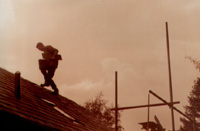
Materials
We considered the
use of resources, embodied energy in production and transport, and ecological
impact on disposal. We also considered the social impact of the businesses
we were buying from.
Reclaimed Materials
Since this was a renovation there was a lot of opportunity for recycling and the use of reclaimed materials.
| Bricks Bricks from the original building's walls were used to build the central fireplace stack. |
 |
Glazing
Double glazing from the original building was reused and fitted with an
extra pane to give triple glazing.
Click here for
more information on glazing
| Roof
slates Natural state from a local mill that was demolished |
|
Timber We used floorboards from a local demolition firm, found in a classified ad in the local paper. We used reused sound timber from the original house for the new timber frame construction. |
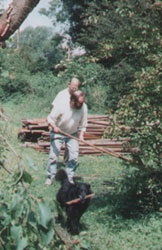 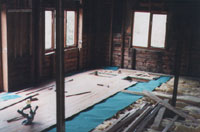 |
|
| Warmcell Insulation in the walls and ceiling is warmcell which is produced from recycled newspaper fibre mixed with fire retardant. |
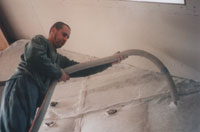 |
|
Warmcell
being blown in through hole
|
| Water
collection tank For the rainwater storage we used 7 2000l reused plastic orange juice containers. We bought them from the tank exchange - 01226 203852. |
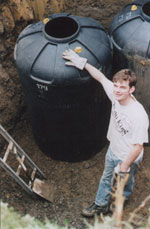 |
New Materials Considering Sustainability
| Masonite First floor and roof construction used Masonite - a wooden 'I' beam that uses a composite board made from the waste sawdust produced in making the top and bottom beams. Natural resin in the wood is used as glue. This produces straight, lightweight joists that can have a depth large enough for good insulation without being too heavy. They have very low chemical emissions. Unfortunately this was only produced in Sweden so had to be imported. Hopefully a similar product will be produced more locally soon. |
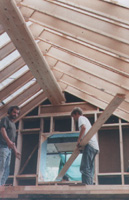 |
| Larch
Board Cladding Outer cladding is 1" untreated English larch from local woods and sawmill. The eaves of the house partially protect it from the weather and it should have a life of 25 years. |
 |
PVC-free Wiring
We used non-PVC wiring for the house. Unfortunately it is very stiff and
made wiring difficult.
| Zinc
Guttering Since we are collecting rainwater to be suitable for drinking we avoided all lead on the roof. We investigated various guttering options: plastic is energy intensive and becomes brittle after a few years. Copper is expensive and toxic with acid rain. Wood guttering needed bituminous preservative that could be carcinogenic and needs maintenance. We used Zinc guttering from Metra Non-Ferrous Metals (01992 460455). |
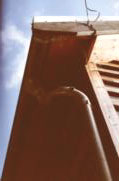 |
Paints
We tried to use low emission paints and preservatives. We used OS Color
and Boracol wood preservative (from Environmental
Construction Products 01484 854898) Auro floor oil (01799 584888).
See also Ecos paints (01524 852371)
What you can do
Construction Resources ecological builders' merchant and building centre have many appropriate products. Tel. 020 7450 2211.
Green
Building Store,
supply "safe sustainable building products."
See the 'What you can do' page for a compilation of tips and links from all sections.
| Home | Principles | Solar | Conservatory | Insulation & Glazing |Energy | Materials | Water | Water Treatment | Land | Report | links | Thanks | Contact us | What you can do |
![]() Web Design by Robin de Carteret 2002 (copyleft)
Web Design by Robin de Carteret 2002 (copyleft)
